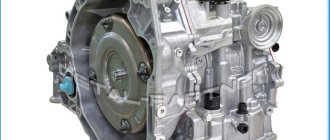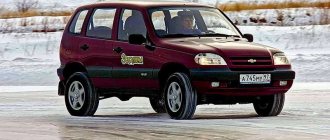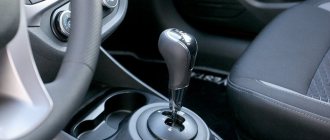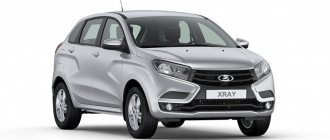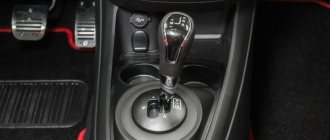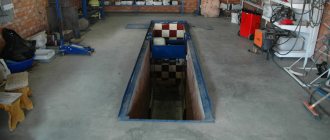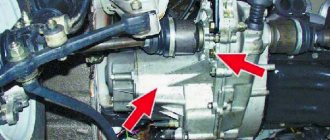In August 2012, sales of the Lada Grant with automatic transmission began; it was the first AVTOVAZ car to have an automatic transmission installed as standard on the assembly line. Almost three years later (in March 2015), sales of the Lada Grant with AMT (automated manual transmission) began. Let's talk about the differences between these two transmissions, which can also be installed on Lada Kalina, Priora, Vesta and XRAY. What are their pros and cons, and which car is better to choose?
A little about the device
The essence of such a box is quite simple - there is a manual gearbox and an electronic control unit for it. With a manual transmission, all the functions that a driver with a manual transmission had to perform (squeezing the clutch, moving the gearbox lever to the desired position) are performed by actuators - servos of the electronic unit.
Thanks to this, the reliability of the gearbox has increased due to the use of classical “mechanics” and the ease of use has increased. The driver just needs to move the selector to the desired position (as in an automatic transmission) and enjoy the ride, and the electronic unit will take care of the gear shift.
With all this, many robotic boxes are also equipped with manual controls, which allows the driver to control the box independently, with the only difference - there is no need to squeeze the clutch.
AMT for LADA Granta. Design Features
Cars of the LADA Granta family (sedan, liftback) have already received a proven AMT, which is installed starting in September 2014.
It was developed by engineers of JSC AVTOVAZ together with specialists from the German concern ZF Friedrichshafen AG, which is the author and owner of many modern technologies and innovative solutions in the field of drive systems. The design of the basic manual gearbox 2181 (modernization of gearbox 2180) was taken as a basis, on which the following were installed:
- 1. Electromechanical actuators that control gear shifting and clutch operation;
- 2. Input shaft speed sensor;
- 3. Controller.
2180 gearbox and electronic control unit
In addition, the following were completely removed from the gearbox:
- 1. Clutch drive;
- 2. Internal switching mechanism;
- 3. Cable gear shift drive.
Inside the car, the clutch pedal was removed, and instead of a mechanical (cable) gear shift drive, an electronically controlled selector was installed.
In addition to original design solutions, modern software was developed specifically for AMT, with the help of which the vehicle’s transmission is controlled.
'); if("undefined"===typeof loaded_blocks_drive){loaded_blocks_drive=[]; function n(){var e=loaded_blocks_drive.shift(); var t=e.adp_id; var r=e.div; var i=document.createElement("script"); i.type=”text/javascript”; i.async=true; i.charset=”utf-8″; i.src=»https://www.drivenetwork.ru/data/»+t+».js?async=1&div=»+r+»&t=»+Math.random(); var s=document.getElementsByTagName("head")||document.getElementsByTagName("body"); s.appendChild(i); var o=setInterval(function(){if(document.getElementById(r).innerHTML&&loaded_blocks_drive.length){n(); clearInterval(o)}},50)} setTimeout(n)}loaded_blocks_drive.push({adp_id:e ,div:t})})(47602)
All these changes, together with the electronic motor control controller and the on-board power supply network, made it possible to fully automate the processes of controlling the clutch and gear shifting, as well as ensuring high AMT functionality.
Control Features
The manual transmission received some operating modes from the automatic transmission, namely:
- "N" - neutral. A mode in which torque is not transmitted to the wheels from the gearbox. That is, the engine is running, rotation is transmitted to the box, but due to the position of the gears, it is not transmitted to the wheels. Used when parking a car for a long time, before starting to move, after stopping;
- "R" - reverse movement. Everything is simple here, the driver moves the selector to this position and the car moves backwards.
Other modes of the robotic box have their own designation:
- "A/M" or "E/M" - forward movement. This mode corresponds to the “D” mode of an automatic transmission, that is, the car moves forward and the gearbox changes gears. In “M” mode manual control is performed. By moving the selector to a certain groove, the required mode is selected;
- “+”, “-” - gear switch. Short-term shifts of the selector to the “+” or “-” side ensure gear shifting in the “M” manual control mode.
What has been improved in AMT
The AMT upgrades of the new Granta are similar to those on the Lada Vesta with 1.8-liter engines:
- The main gear ratio has been increased from 3.710 to 3.940. This means increased fuel consumption, reduced noise and vibration levels in the transmission, and more dynamic acceleration.
- New AMT operating modes have appeared: creeping, sports and winter.
- AMT gear shift time has been reduced by almost a third.
- In the AMT clutch, the driven disc has increased heat resistance and the friction linings have become thicker, which, coupled with new algorithms, makes field driving more confident.
Is it necessary to warm up the box?
It seems that everything is simple, and there is nothing complicated in controlling such a box - just move the selector to the desired position and start moving. Still, you should know how to control the robot box so that it works without problems.
Let's start with an interesting question - is it necessary to warm up the gearbox before driving in winter? For an automatic transmission in winter, warming up is mandatory and is performed by briefly moving the selector to all positions.
The robotic gearbox is essentially mechanical and does not require warming up. And yet, in winter, the manual transmission should be warmed up before driving, although this is not exactly warming up. When parked, the oil in the box flows down and thickens due to frost. Therefore, it is recommended in winter, after starting the engine, to give time so that the oil does not warm up, but simply spreads over the elements of the box, reducing friction between them. It’s enough to just stand for a couple of minutes with the engine running, and you don’t need to switch the selector to different modes, just keep it in the “N” position. After this, you need to start moving smoothly, without sudden jerks, and drive for at least 1 km, which will ensure complete heating of the oil.
Starting the climb, overcoming it, descending
Many cars with manual transmission are not equipped with a hill start assist system, so the driver himself needs to learn how to start driving correctly. When starting uphill, you must proceed with the robotic gearbox in the same way as with the “mechanics”. To start driving, the selector is switched to mode “A”, the accelerator is smoothly pressed and at the same time the car is removed from the handbrake. This action will prevent the car from rolling back. You should practice pressing the gas and releasing the handbrake at the same time so that the driver can feel the engine and understand when the clutch has started to engage and can be released from the handbrake.
When starting to climb in winter, it is better to use manual mode and set the car to first gear. It is not worth accelerating too much to avoid wheel slipping.
When driving uphill with the automatic mode selected, the box will begin to shift to lower gears on its own, which is quite logical, because at higher speeds it is easier to overcome the climb. This gearbox is equipped with a gyroscope that determines the position of the car, and if the sensor shows a rise, the box will work accordingly. You can also move in manual mode by locking in a specific gear. It is important to understand that the manual transmission will not allow you to move under tension, so when climbing, the engine speed should be at least 2500 rpm.
When descending, no action is required from the driver. It is enough to move the selector to position “A” and remove the handbrake. In this case, the car will perform engine braking.
Lada Vesta SV Cross 1.8 AMT - issue price
The AMT robotic gearbox of the Lada Vesta SV Cross will be available to customers only with a 122-horsepower 1.8-liter engine. Manufacturers decided that there was no point in installing a robot together with a 1.6 liter engine. The 1.8 liter engine will also be available with a manual transmission.
As for the price, the additional payment for the AvtoVAZ robotic gearbox will be exactly 25,000 rubles, which is not a large amount in today’s money. Moreover, for these 25 thousand rubles you get a serviceable and inexpensive to maintain automatic transmission, albeit a robotic one.
From words to numbers...
The cheapest configuration of the Lada Vesta SW Cross, in which AMT can be installed, is LUXE. Equipment code GFK32-52-X00. This pleasure costs 820,900 rubles. For this money you will receive a fully equipped car with all the necessary functions with a good level of comfort and safety.
The next configuration will be Luxe Multimedia. Part number: GFK32-52-XK2. Price 848,900 rub. The difference with the LUXE package is in the multimedia system. The simple luxury trim has only a four-speaker audio system, while the Luxe Multimedia has a multimedia system with navigation and six speakers. All other characteristics of these configurations are the same.
Stop, parking
And the third important issue is the correctness of parking and stopping. After the car has come to a complete stop, the selector must be moved to neutral “N”, put on the handbrake and then turn off the engine. During short stops, moving the selector to neutral is not necessary; it is quite possible to remain in mode “A”. But it is worth considering that when stopping, the clutch remains depressed. Therefore, in a traffic jam or at traffic lights, when the stop takes longer, you should still switch to neutral.
Other modes
These are the basic rules on how to operate a robotic box. But there are other features, for example, some manual transmissions have additional modes - sport and winter, the so-called “snowflake”.
“Snowflake” is aimed at starting movement on an icy road as smoothly and without slipping as possible. All it does is ensure that the car starts straight from second gear and makes upshifts smoother.
The “sport” mode switches to higher gears at higher speeds than in normal mode. This allows you to accelerate faster. That is, if in normal mode the transition to 2nd gear was performed, for example, at 2500 rpm, then in the “sport” mode this transition will be carried out at 3000 rpm.
Now about the possibility of switching from automatic to manual mode and back while driving. The robotic box allows you to do this without any problems. It is also possible to independently downshift or upshift to change the speed of movement. But it is worth considering that the electronic unit will not completely transfer control of the box; it will constantly monitor the operation.
Useful tips
Finally, some recommendations for the operation and maintenance of the robotic box.
This gearbox does not tolerate sudden pressure on the gas pedal, so it is better to drive in a quiet mode. Even if you need to speed up, it’s better to press the accelerator smoothly, while switching to manual mode. And when braking, you should do the opposite - switch to automatic mode.
A feature of manual transmission is the presence of small shocks when changing gears. You can get rid of them quite simply - when changing gears, reduce the engine speed, that is, act by analogy with a conventional manual transmission.
The presence of a manual mode even allows you to perform a “rocking” exit if the car gets stuck in a snowdrift. But at the same time, this will not benefit the gearbox, since slipping on a manual transmission is not recommended, this can lead to decalibration of the actuators. Therefore, it is still better to remove a stuck car with outside help.
During each maintenance, it is necessary to initialize and diagnose the condition of the manual transmission, which will allow you to eliminate all faults of the box at an early stage.
There are other small features of such boxes that depend on the manufacturer. It is better to inquire about them immediately, so that in the future there are no misunderstandings with the operation of the robotic box.
The development of the automotive industry does not stand still. People are trying to improve their lives, make it more comfortable and convenient. Car manufacturers are trying to make driving as easy as possible for their customers. Due to this, various technologies are constantly being improved. Thus, an automatic clutch was attached to the manual transmission. By putting these two elements together, the developers received a so-called robotic transmission, combining all the advantages and disadvantages of the units. People also know the name “robot box”.
Don’t delay diagnostics and repairs
By the way, maintenance usually only means changing the oil and filter, although it would also be nice to monitor the oil level during each routine maintenance. But, firstly, the box may require firmware updates (especially if we are talking about new models), additional operations as part of service or recall campaigns. Secondly, it is important not to delay diagnostics and repairs when signs of a malfunction appear (shocks and shocks during switching, vibrations during start-up and acceleration), since further driving can lead to more serious troubles, and as a result, more expensive repairs.
Gearbox device
When clarifying the features of such a design, you need to pay attention to the relevant reviews. The robot box requires specific handling, but in order to understand why, you will need to understand its structure.
Based on the preliminary description, one might think that the overall design is a simple machine with special controls. However, it is not. Let's consider this issue in more detail.
The design is based on a manual transmission, which, according to reviews from both professionals and ordinary drivers, is considered more reliable than an automatic one. This can be understood by reading reviews on the Internet. The robot box has special devices. They are necessary in order to depress the clutch when changing gears.
It is worth noting that when using a conventional manual transmission, the driver independently chooses the shift time. To do this, he focuses on what is happening on the road and uses the clutch pedal in conjunction with the transmission lever itself. When developing a new device, which received controversial reviews from drivers, the robot box showed itself from a completely different side. It was decided to exclude the direct actions of the driver from the above process. All important switching is carried out by the computer. For the successful functioning of the robot, special actuator units were installed. Thanks to them, gear shifting, controlled by the computer itself, became possible.
Judging by the reviews, consumers note several main advantages. We are talking about huge fuel savings and ease of repair. Also, some consumers like the absence of a clutch pedal. Another advantage highlighted by drivers is that it is possible to manually change gear.
Domestic and foreign competitors AMT Grants
The exterior of the improved Lada Granta robot is no different from its brothers in the shop with other gearboxes. The external design is laconic and solid, perfect for modern motorists.
The interior design is also the same, but on the front panel between the speedometer and tachometer, the robot has an engine temperature indicator. There is also a warning light that lights up when the driver makes incorrect actions and attempts to start the car without pressing the brake pedal.
The cost of the new model differs slightly from a car with automatic transmission. The difference is approximately 20 thousand rubles, so when choosing transport you should not focus solely on the price category. The difference with mechanics is also small. Therefore, almost all motorists can afford an improved model.
The main competitor among VAZ's developments for the Granta with a robot will be the Granta with a machine gun. The Japanese box has attracted the attention of many buyers and the reviews about it are very positive.
The significant difference between the two types is the ease of control: the automatic is smoother, more accurate and not so difficult to get used to. The robot attracts with its low fuel consumption, but can produce slight jerks when switching and puts a large load on the clutch in city driving conditions.
Among the foreign cars, there was also a competitor for the robotic Grant. Despite the love of drivers for the domestic automobile industry, the possibility of carrying out simple and inexpensive repairs, and the budget price, some buyers preferred the Japanese Datsun mi-DO.
The model's appearance is more attractive and coherent than Grant's. But repairing and maintaining such a car will require significant costs. Therefore, not all drivers will want to purchase a platform mate (the Datsun mi-DO based on Kalina is produced).
How does it work?
The box in question operates using actuator units, which we have already discussed earlier. They collect information about such details as driving speed, power unit speed, and the operation of some sensors. Based on the received data, the computer makes a decision about which transmission needs to be activated. As far as drivers know, the servo is responsible for the clutch. It is he who receives the command to change the mode and disconnects the engine from the input shaft. During this process, the second servo is activated, it selects the gear that is needed and instantly turns it on. After a second, the engine is reconnected to the shaft, and the car continues on its way. This whole process happens as quickly as possible, so the person doesn’t even notice. All he can notice is a small impulse, but nothing more. This is exactly how this “robot” gearbox works. We'll look at the reviews below.
Servo drives come in two types. There are electric and hydraulic. The first is a motor that is capable, using a gearbox, of moving the executive part. The hydraulic one operates through a special cylinder. It receives commands directly from the control unit.
Transmission Benefits
During use, drivers identify existing disadvantages and advantages. Of course, we need to talk about them too. What statements can you come across when researching reviews? The robot box has its own characteristics. Let's first look at the benefits.
- Consumers note that, unlike an automatic transmission and a CVT, a robotic gearbox is reliable and more convenient.
- Almost all models of the described transmission are capable of operating in manual mode, in which the driver can change gears himself.
- Many buyers notice that the robot box (positive reviews predominate) has a much smaller working volume. Accordingly, a small amount of oil is needed.
- If you put cars with different transmissions in the same driving conditions, then the consumption of the robotic one is much less than that of others.
- The clutch of the described gearbox has a 30% higher service life.
- Consumers have noticed that the maintenance and repair work of such a transmission is much cheaper.
- The weight of a robotic gearbox is not as heavy as that of an automatic one. Due to this, it is easier to install it on a small car.
The latest generation of Lada Vesta with mechanics and real reviews from car owners
It is quite reasonable that the new Lada Vesta AMT and reviews from owners have their fans, but the current manual transmission is also not losing ground. Most car owners note that compared to the old box, the noise level is significantly lower. In addition, the advantages of JH3 include:
- More precise adjustment of switching mechanisms.
- The defect of difficult gear changes caused by oil thickening at low atmospheric temperatures has been eliminated.
- Clear shifts and reliable locking of the gearbox lever.
Almost all positive reviews of Lada Vesta mechanics are characterized by the opinion of Pavel T. from Tambov:
“If anyone drove the previous models, they will immediately feel the difference. The JH3 manual lever from Renault pleases with its moves and selectivity. Unlike the Lada 2181 gearbox, which uses a cable shift mechanism, the imported manual transmission is significantly quieter.”
Conflicting opinions are caused by the fact that the French box is maintenance-free. If in the previous design of the manual transmission the hum could be weakened by replacing the transmission lubricant, now the plant fills in lubricating fluid for the entire operating life.
Despite the warranty obligations of AvtoVAZ, experts still recommend changing the oil every 100,000 km. It is rational to combine this procedure with changing the clutch. In addition, be sure to monitor the transmission fluid level, which should not be lower than the lower edge of the filler hole. It seems that everything was done with the car enthusiast in mind, but, for example, reviews from the owner of a Lada Vesta with a manual transmission, Andrei P., contain some complaints:
“You will hardly be able to immediately engage reverse gear on a manual transmission. The car service is not able to offer anything, citing imperfections in the design... Over time, I adapted (what to do) - I first turn on third gear, and then reverse. This “imperfection” is especially noticeable in winter, when the lubricant thickens.”
Disadvantages of the gearbox
Even with such a list of advantages, the device also has its disadvantages, which may scare off some drivers. Let's look at them.
- Unfortunately, the most commonplace and cheapest robotic boxes are not able to adapt to the particular driving behavior of a particular driver. In this it was surpassed by the automatic transmission, which easily adapts to the driving style. There is only one type of driving here. It is built into the firmware as standard.
- If the robot box (reviews in this regard are quite negative) is installed in conjunction with an electric servo drive, then it shows a slight delay in operation. That is, the resulting pause between signal transmission and the switching itself sometimes reaches two seconds. This is not a serious drawback, but it can cause inconvenience when driving evenly and accelerating.
- If a hydraulic drive is used together with a robotic gearbox, then it should be noted that the switching speeds up to almost 0.05 seconds. This seems like a small number, but you can feel it while driving. But such a drive is both expensive to buy and expensive to install. Moreover, it heavily loads the engine in terms of energy, which is why it is often used in sports cars or other expensive cars.
Development of the gearbox - the emergence of preselective
Due to the fact that the box has its shortcomings, the first developments were received rather poorly. The main thing that drivers did not like was the jerks that appeared when driving. Most likely, this was felt due to the low speed of operation. But the developers, due to the low cost and ease of assembly, continued to look for solutions to the problems that arose.
In order to correct the situation and reduce the delay time when switching, designers began to use boxes together with two clutches that operate independently of each other. This made it possible to completely get rid of significant delays and jerks. The dynamics of the car have increased significantly; Also, consumer demand has increased sharply. Even then, the robot box began to gain popularity. Owner reviews gradually became better.
Now let's talk about who was the first to use robotic gearboxes. The pioneers are Audi and the German Volkswagen. They have been installing such transmissions on their cars since 2003. Reviews about exactly how the gearbox works on their cars will be described below.
What were the benefits of using a double clutch? Due to it, the required gear is switched on before the previous one is switched off. And thus the car continuously moves from one to another, while maintaining traction in the required volume. This robotic gearbox is called preselective. She is the second generation. Returning to the design of the device, it must be said that a regular box of any type works with one primary and secondary shaft. The same design received two of them. For what? Each pair is responsible for either odd or even transmission. The primary shafts are arranged like a nesting doll, that is, one is nested inside the other. They are connected to the power unit via a multi-disc clutch.
Advantages and disadvantages of the second generation
By combining all the best developments in the second generation gearboxes, that is, those that operate with double clutch, they received a more economical and faster driving technology. They are also extremely comfortable to use. Due to its small volumes, such a box is more rational and cost-effective to use in small cars than an automatic one.
But even with a lot of advantages, there are also some disadvantages. For example, unlike the first generation, such a transmission is much more difficult to repair. Moreover, this will amount to a decent amount, which not all drivers have at their disposal. There was also previously a problem with torque, but now this nuance has been completely eliminated.
Lada Granta AMT: conclusions and performance characteristics
| We like | widespread work on bugs; new rear view mirrors; a domestic robot that is better than Opel’s and Toyota’s. True, mid-2000s. |
| We do not like | nostalgic communal crampedness |
| Data is given for Lada Granta AMTc with 1.6 engine and MT | |
| Engine | petrol |
| Number and arrangement of cylinders | 4 in a row |
| Working volume, cm³ | 1 596 |
| Max. power, hp | 102/5800 |
| Max. torque, Nm | 148/4000 |
| Drive unit | Front |
| Transmission | robotic, 5-speed |
| Front suspension | independent, with McPherson struts and anti-roll bar |
| Rear suspension | semi-independent, lever, spring |
| Front brakes | d claims |
| Rear brakes | drums |
| Maximum speed, km/h | 180 |
| Acceleration time sec. | 12,3 |
| Dimensions, mm | |
| length | 4 260 |
| width | 1 700 |
| height | 1 500 |
| wheelbase | 2 476 |
| ground clearance | 160 |
| Curb weight, kg | 1 075 |
| Tires | 175/65 R14 |
| Trunk volume, l | 520 |
| Fuel consumption, l/100 km | |
| urban cycle | 9 |
| suburban cycle | 5,2 |
| mixed cycle | 6,6 |
| Fuel tank volume, l | 50 |
We thank AMK-Ekaterinburg for the test car. Text: Kirill Zaitsev Photographer: Nikolay Kovalevsky Illustrations, graphics: Jatco, Renault, Lada, archive 66.RU
Roskomnadzor killed the Telegram bot 66.RU. Subscribe to the backup channel.
Robot box on an Opel car
In the model range there are sometimes cars with a robotic gearbox. Unfortunately, there are more negative reviews about them than positive ones. Perhaps this is his own fault.
The robotic gearbox, which we are reviewing reviews of, only works with 1 clutch. This brings some discomfort, as the driver can feel the gear shift process. Most cars are equipped with just this option, but there are also models with the second generation.
According to reviews, it will take quite a long time to get used to the box, it is specific. However, this is possible, and after a decent interval of time it becomes as convenient to use as possible. Separately, they note that the price tags for such machines and gearbox repairs are low, so this can be identified as a separate advantage. It allows you to close your eyes to frivolous disadvantages.
Drivers often note that it is necessary to regularly reconfigure the clutch. Due to the fact that this issue was practically not taken care of, the robot box (there are reviews about this all the time) seems to live its own life. It does not adapt to the driver’s driving style, so sometimes it can even get confused.
In general, few people advise purchasing a car with a robotic gearbox. If you still want to try it, then you should take a closer look at the most expensive options. However, you need to take into account that you will have to watch twice as carefully on the road so as not to miss it if the gearbox suddenly starts to “slow down”.
Granta 1.6 16v AMT (robot)
I wish you all good health! Reading reviews is of course pleasant and useful, now you also need to make your contribution, so don’t judge harshly, especially for mistakes (I was in a hurry, and I want to write more + no, the beech is stiff and the buttons are small).
Lada Granta (luxury equipment)
ICE: 1.6; 16th grade; 106 l/s, gearbox: 5st. robotic.
Equipment: ABS; 2PB; 4ESP; Climate; Heated front seats; Rain sensor; Two rear parking sensors; Fogs; Wheels R15; Radio with touch control; Standard alarm.
Over 11 years of driving experience, I personally owned: the first was my grandfather’s Moskvich 412 (whatever this car couldn’t stand from me), then the VAZ 2105 1.3 85 onwards. on gas (after Moskvich, a comfortable and stable car), VAZ 2106 2006. (drove for about 2 years), then an almost new 2105 (injection 5-speed, also drove for about 2 years), Toyota Platz 2001. (I got the car in excellent condition, drove it for 3 years, didn’t know any problems, but I wanted more and lost it), Nissan Cefiro 1998. 2.5 210 hp Neo-Di engine which does not run on gasoline below 95, the car is cool but already old and it eats gasoline normally + expensive insurance, taxes (drove for 2 months and sold it), Honda Civic 2000. 1.5 (8 valve automatic - I was shocked myself) right-handed sedan made for the Emirates, no ABS, no airbags, terrible heater. but there is a leather interior and climate control (the car was received in poor technical condition. I thought I’d do it little by little, but it didn’t work out due to financial difficulties, I thought it was about to break down BUT! the car was almost unchanged in technical parts, traveled 3 -and years... low bow to her, the car is really very reliable and durable, although it is designed for good roads and active driving, so the chassis is quite harsh). All cars are worthy of special attention, but we are not talking about them now. And now. TA-DAM! New Lada Granta))
Robot box on the Opel Astra
We have already discussed the general situation regarding Opel above; I would like to separately touch on the Astra car, which used a robotic gearbox. “Astra”, reviews of which are controversial, but not bad, received a first-generation design, so we can say that it is designed for an amateur. Moreover, we are talking about the process of operation, and not about repair. Some drivers note that it is better with such a gearbox than with a manual one. However, its work is much worse when compared with the conventional and most famous automated one. Many robot boxes don’t like traffic jams and sometimes start to malfunction. Depending on the nature of the failure, the unit can be much cheaper to repair than an automated transmission. However, it cannot be said that this is really true in all cases.
AVTOVAZ announced prices for the new LADA Granta
The updated LADA 4×4 entered the production line
Up to 100 km/h, the Granta shoots excellently, but at slightly higher speeds you realize that the dynamics are no longer so impressive. In general, long overtakes should be planned in advance.
The manual transmission surprised me in a good way. It works with the clarity of an automatic shutter and there has never been any confusion between “first” and “third”. Moreover, each transmission is quite “long”. For example, in “second” it is quite possible to accelerate the car to 80 km/h. In any case, the tachometer needle is not yet entering the red zone. In other words, even in a traffic jam, you don’t have to pull the gearbox handle often.
The new LADA Granta is now available not only in sedan and liftback body styles, but also in hatchback and station wagon. Thus, in terms of reaching a potential audience, AVTOVAZ has closed all the holes that appeared after the Kalina was discontinued from production, from which, in fact, a couple of new bodies were received.
With the advent of the updated LADA Granta line, it has every chance to once again regain its leadership in the sales ranking on the Russian market, which the Koreans brazenly took away from AVTOVAZ. Or doesn't it?
Robot box on Toyota Corolla
Considering that each person has his own preferences in choosing a car and its transmission, the driver will decide for himself whether this Toyota is suitable for him. The robot box, which has good reviews in 80% of cases, shows normal operation. However, it still has some disadvantages.
Before purchasing a car, many people think about which transmission will be better? To do this, let's look at the advantages and disadvantages. We will do this taking into account the feedback from the robot box.
Drivers' odes of praise are dedicated to the Corolla with such equipment. They say that a small amount of fuel is consumed during operation. Moreover, it is easier to maintain and much cheaper. But there are also disadvantages. Which ones? The automatic changes gears somewhat faster than the robot. Sometimes the smoothness of operation fails, which affects the dynamics of the ride and comfort in general. And also, before driving anywhere in winter, you will always have to warm up the car. Otherwise, there is a high probability that the transmission will malfunction.
Not all drivers enthusiastically accept the fact that a robotic gearbox is installed on the Toyota Corolla. Reviews from most consumers make it clear that the machine is easy to operate and problems rarely arise. But again, it is necessary to understand the specifics of the operation of such a transmission and be ready to adapt to it.
Robot box on a Lada car
Let's consider a legendary car from a domestic manufacturer with a robotic transmission. Let's try to understand the advantages and disadvantages, taking into account the reviews. Lada-Vesta, whose robot box is not liked by all consumers, has become widespread on the market. Everyone writes that it will take a long time to get used to, but this is not a problem at all.
There are a lot of good reviews on the Internet. They make it possible to understand that the main problem of such a box is only the switching speed is too low (compared to an automatic transmission). Quite often, drivers do not use manual mode; as a rule, the situation does not require it. Often, an urgent need appears only when driving in a large flow of cars. And as you know, the gearbox does not adapt to the driver’s particular driving style, so it is safer and more profitable to use the manual mode.
Some consumers don't like the prospect of self-driving at all, because the transmission is given to the computer, and it must always control it without human intervention.
Also, among the advantages, consumers note that the robotic gearbox does not heavily load the power unit, so the ride is as convenient and comfortable as possible. The process of changing gear after acceleration occurs quite quickly. However, working with one clutch is practically a thing of the past. This greatly hinders the development of such gearboxes, because the first generation models receive a lot of negativity, and this reduces the popularity of the device itself.
In general, Lada Vesta is considered a normal, inexpensive option. As a rule, it is purchased by those who are just learning to drive; more advanced people do not pay attention to it.


